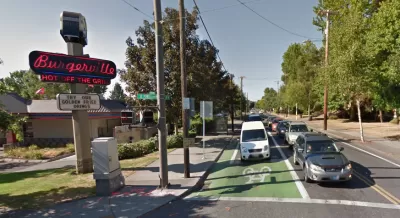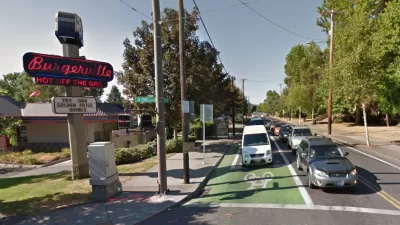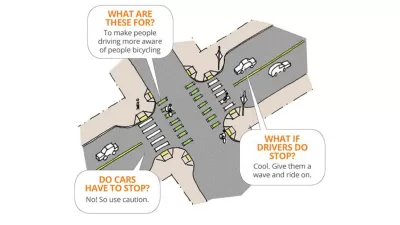A bike advocate tells the story of the how the state department of transportation convinced local officials to remove a popular bike lane in Portland.

"Two of southeast Portland’s most-ridden bike lanes are slated to be removed at the insistence of the state of Oregon," reports Michael Andersen.
According to Andersen, the "[bike lanes on each side of Southeast 26th Avenue near Powell draw something like 600 to 800 people per day (even in winter) and run in front of Cleveland High School. They will be paved over sometime in the coming months and not replaced." The decision comes from the Oregon Department of Transportation (ODOT), which announced the project last week.
The city of Portland, however, had to accept the decision of the state to remove the lane, despite disagreement over the potential safety impacts. The ODOT believes that removing the bike lane will improve safety at the intersection of SE Powell at SE 26th by reducing the number of bicycles on the street. Many bike riders, according to an ODOT spokesperson, will switch to 28th Avenue instead "when a new traffic signal and neighborhood greenway are installed there in the coming months."
Andersen clearly opposes the removals, providing several examples of evidence and policy maxims that contradict the claims made by the ODOT. By providing a lot more information on this specific example and the other projects and events that led to the decision to pave over the lanes, Andersen also provides an unfortunate case study of a city and a state failing to resolve differences in their approaches to streets.
FULL STORY: City gives in to state demand to remove bike lanes from SE 26th Avenue

Alabama: Trump Terminates Settlements for Black Communities Harmed By Raw Sewage
Trump deemed the landmark civil rights agreement “illegal DEI and environmental justice policy.”

Study: Maui’s Plan to Convert Vacation Rentals to Long-Term Housing Could Cause Nearly $1 Billion Economic Loss
The plan would reduce visitor accommodation by 25% resulting in 1,900 jobs lost.

Why Should We Subsidize Public Transportation?
Many public transit agencies face financial stress due to rising costs, declining fare revenue, and declining subsidies. Transit advocates must provide a strong business case for increasing public transit funding.

Paris Bike Boom Leads to Steep Drop in Air Pollution
The French city’s air quality has improved dramatically in the past 20 years, coinciding with a growth in cycling.

Why Housing Costs More to Build in California Than in Texas
Hard costs like labor and materials combined with ‘soft’ costs such as permitting make building in the San Francisco Bay Area almost three times as costly as in Texas cities.

San Diego County Sees a Rise in Urban Coyotes
San Diego County experiences a rise in urban coyotes, as sightings become prevalent throughout its urban neighbourhoods and surrounding areas.
Urban Design for Planners 1: Software Tools
This six-course series explores essential urban design concepts using open source software and equips planners with the tools they need to participate fully in the urban design process.
Planning for Universal Design
Learn the tools for implementing Universal Design in planning regulations.
Smith Gee Studio
Alamo Area Metropolitan Planning Organization
City of Santa Clarita
Institute for Housing and Urban Development Studies (IHS)
City of Grandview
Harvard GSD Executive Education
Toledo-Lucas County Plan Commissions
Salt Lake City
NYU Wagner Graduate School of Public Service





























